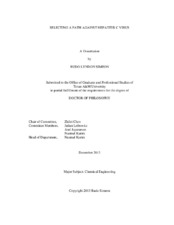| dc.description.abstract | Hepatitis C virus (HCV) currently affects ~5% of the world’s population and has relatively limited treatment options for infected patients. Genetic suppressor elements (GSE) derived from a gene or genome of interest can act as transdominant inhibitors of a particular biology function presumably by binding to and blocking an essential interaction surface for protein activity. Taking advantage of hepatoma cell line n4mBid, that supports all stages of the HCV life cycle and strongly report HCV infection by a cell-death phenotype, we developed an iterative selection/enrichment strategy for the identification of GSE against HCV. Using this strategy, a library expressing random fragments of the HCV genome was screened for sequences able to suppress HCV infection. A 244 amino acid gene fragment, B1, was strongly enriched after 5 rounds of selection. B1 has a very high net positive charge of 43 at neutral pH and a high charge-to-mass (kDa) ratio of 1.5. We show that B1 expression specifically inhibits HCV replication, apparently due to its high positive charge. We also show that recombinant positively charged proteins can inhibit HCV infection, when supplied in vitro.In addition, eGFP-fused B1 potently penetrates both adherent and suspension cells with >80% of cells taking up the protein. Importantly, we show that B1 not only facilitates cellular uptake, but allows protein cargo to reach sites of biological relevance. B1 also delivers non-covalently conjugated RNA and DNA across the cell membrane to cytosolic and nuclear sites, with efficiency comparable to commercially available cationic lipid reagents. Our data suggest that B1 utilizes cell-surface glycans and multiple competing endocytic pathways to enter and traffic through cells.During a separate screening carried out in our lab, we identified a TACR3 inhibitor SB 222200 that had significant HCV activity. We go on to show that both TACR1 and TACR3 receptors are expressed in the HCV-permissive Huh 7.5 cell line. We also show that both TACR1 and TACR3 inhibitors significantly inhibit HCV infection. These results point to the potential for TACR1 antagonists in treating patients infected with both HCV and HIV. | en |


